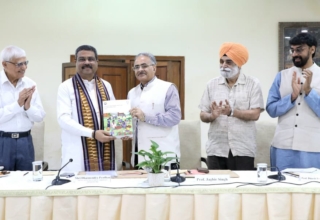
Merit list will be prepared by participating Universities/ organisations. Universities will decide about their individual counselling on the basis of the score card of CUET (UG) – 2022 provided by NTA.
Common University Entrance Test (CUET UG), the mammoth entrance exam for admission to Under Graduate programs in 90 universities including all 44 central universities , which dominated the higher education discourse since its announcement in March this year, conclude on September 15 with the online declaration of result score cards. The Result is available on https://cuet.samarth.ac.in
NTA or the National Testing Agency which conducted this exam in a statement has said that it has no role beyond hosting score cards. “The Role of NTA is confined to registration of candidates, conduct of the test, hosting of answer key, inviting challenges, finalising answer keys, preparing and declaring result and hosting Score Card. Merit list will be prepared by participating Universities/ organisations. Universities will decide about their individual counselling on the basis of the score card of CUET (UG) – 2022 provided by NTA,” the statement said.
The candidate’s particulars including Category and Person with Disability (PwD) have been taken by NTA as mentioned by the candidate in the online Application Form. Results of candidates are being shared with the Universities where the candidates had applied. Candidates are advised to be in touch with the respective Universities and Institutions for further details.
CUET-UG 2022, which was taken approximately by 14,90,000 in two shifts was conducted in 259 cities in India, and also conducted in 10 cities outside India in Manama, Doha, Dubai, Kathmandu, Muscat, Riyadh, Sharjah, Singapore, Kuwait City, and New York. The test was conducted in remote areas like Navsari, Itanagar, Barpeta, Nalbari, Araria, Arrah, Begusarai, Bettiah, Bhabua, Buxar, Jammui, Samastipur, Bilaspur, Deoghar, Kargil, Leh, Morena, Behrampur, Bhadrak, Jajpur, Jharsuguda, Sambalpur, Sriganganagar, Balia, Basti, Chandauli, Ghazipur, Mau, Sonbhadra, Srinagar (Uttrakhand) also in addition to other cities.
Also, for the first time, the medium of the Question Paper was in 13 languages (English, Hindi along with regional languages i.e. Assamese, Bengali, Gujarati, Kannada, Malayalam, Marathi, Odia, Punjabi, Tamil, Telugu, and Urdu) so that the candidate from different regions could attempt in their own medium and feel comfortable to write and understand the pattern/method of the examination.
The rationale behind switching over to one-India, One- universities entrance test was to provide a common platform and equal opportunities to candidates across the country, especially those from rural and other remote areas and help establish better connect with the Universities. “A single Examination enabled the Candidates to cover a wide outreach and be part of the admissions process to various Central Universities and other participating Universities,” NTA said.
The candidates applied for 54,555 unique combination of subjects across 90 Universities. The total number of Question Papers was 2219 and the number of Questions was 50476. An overall choice in all subjects was given to all candidates in order to cater to the decision of different Boards across the country regarding the reduction of the syllabus.
To enhance the Quality of Examination Centre, NTA with the support of UGC and AICTE had increased its capacity by adding new institutes as Examination Centres and also improving the quality of Centres so as to enhance the experience of candidate in taking the examination. Also 02 National Coordinators, 18 Regional Coordinators, 250 City Coordinators, and 505 Observers/Deputy Observers were positioned. Live CCTV Surveillance was planned in all examination centres to curb malpractices in the examination. The NTA also made arrangements for live viewing of remote locations of all examination centres from the Control Room located in the NTA premises of New Delhi. Recording of CCTV Systems was also done. The examination centres were also monitored using AI-based Video Analytics and virtual observers.
In order to stop cheating using mobile networks, Jammers were installed in all the Centres. Candidates were given an opportunity to see their responses to the Question Papers and to challenge the Answer Keys. Challenges received online were placed before the concerned Subject Experts for verification. The Result was prepared based on the Final Answer Keys.
However, the six-phase CUET-UG was not without its share of controversies and tensions. Technical glitches, last minute cancellations were reported though no crash of portal was seen even at this volume. A detailed analysis and more reports as the admission process proceeds from here will give a better view of how much purpose has it solved and if there is scope for more improvement into the exam itself from next year.










